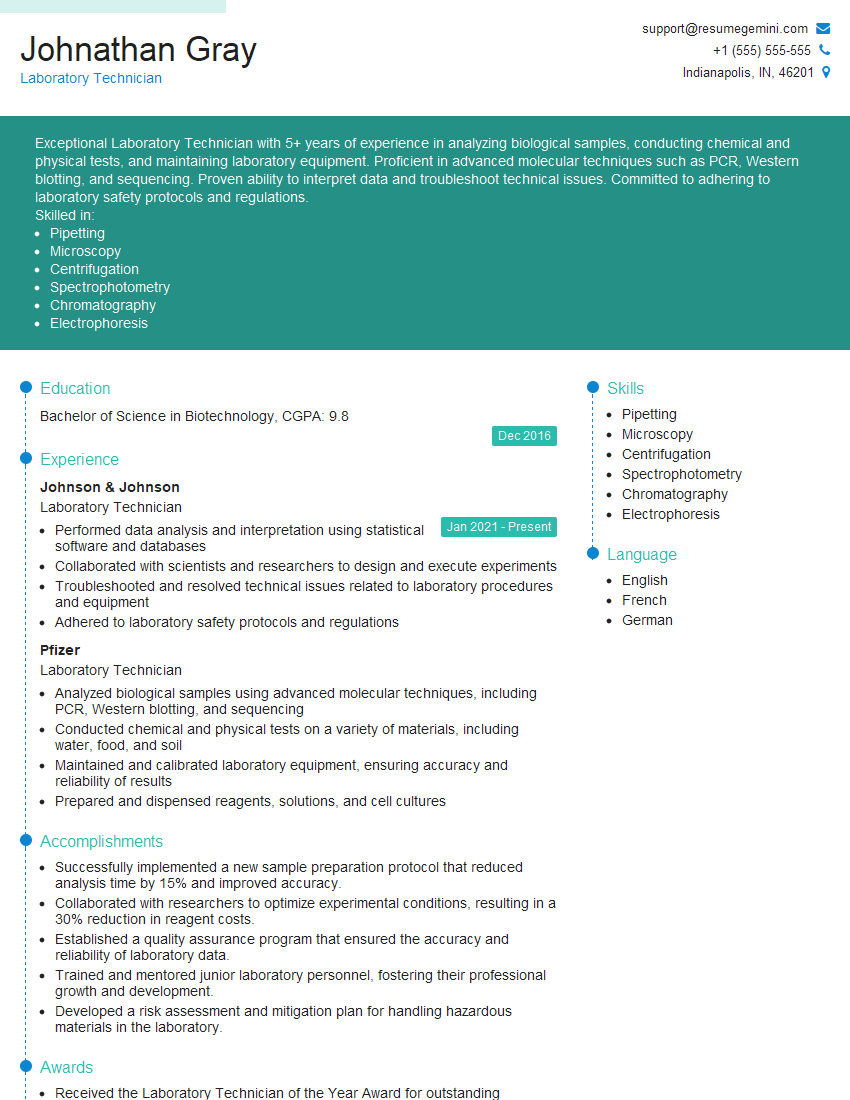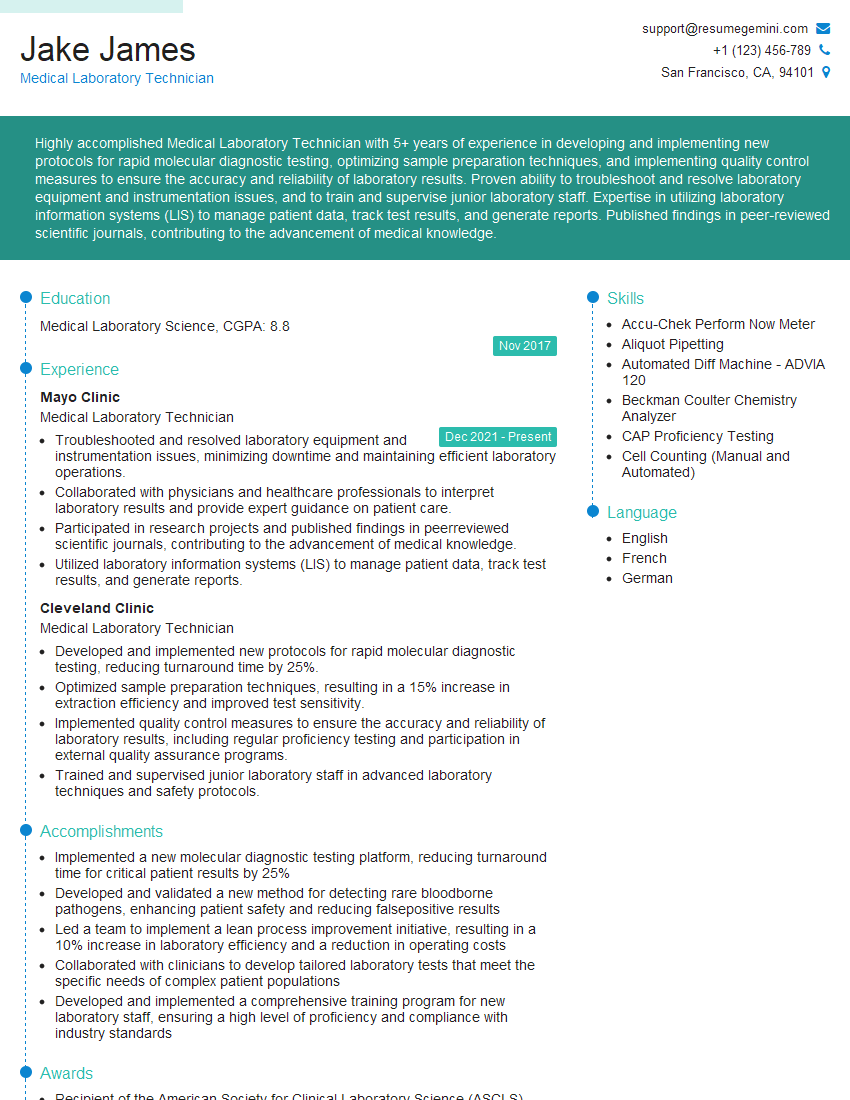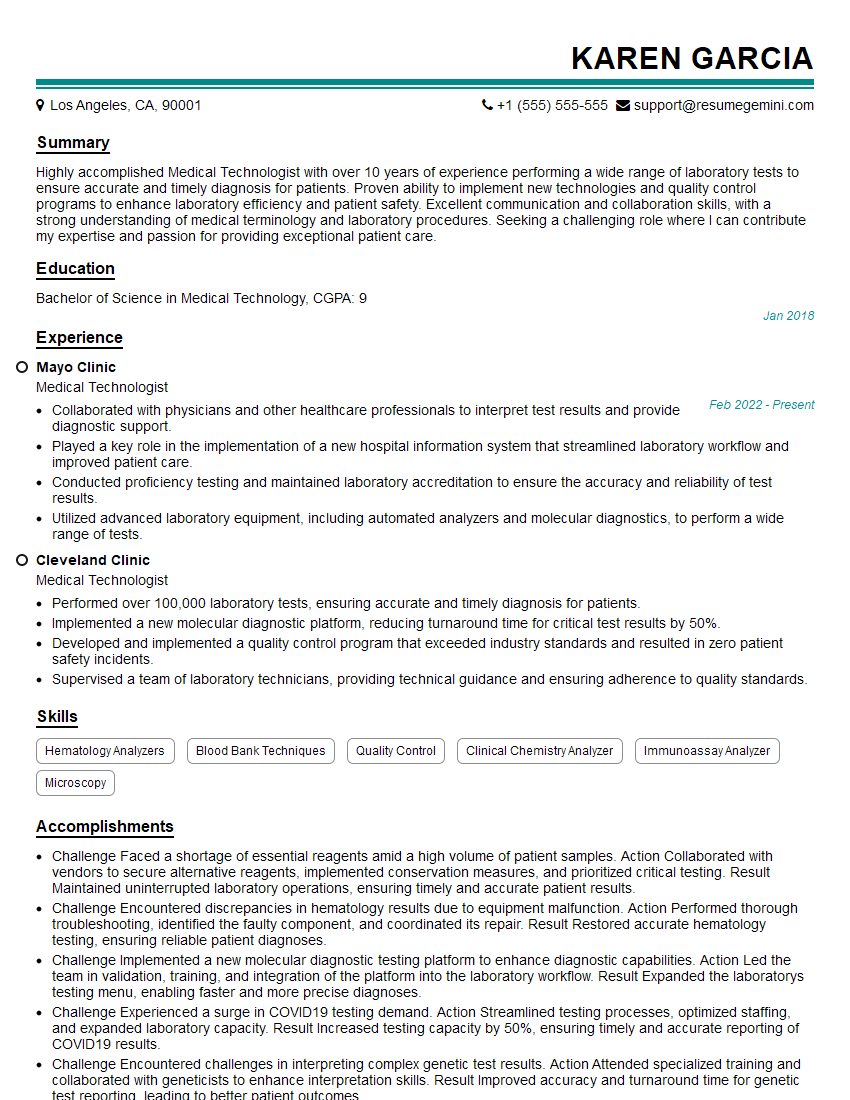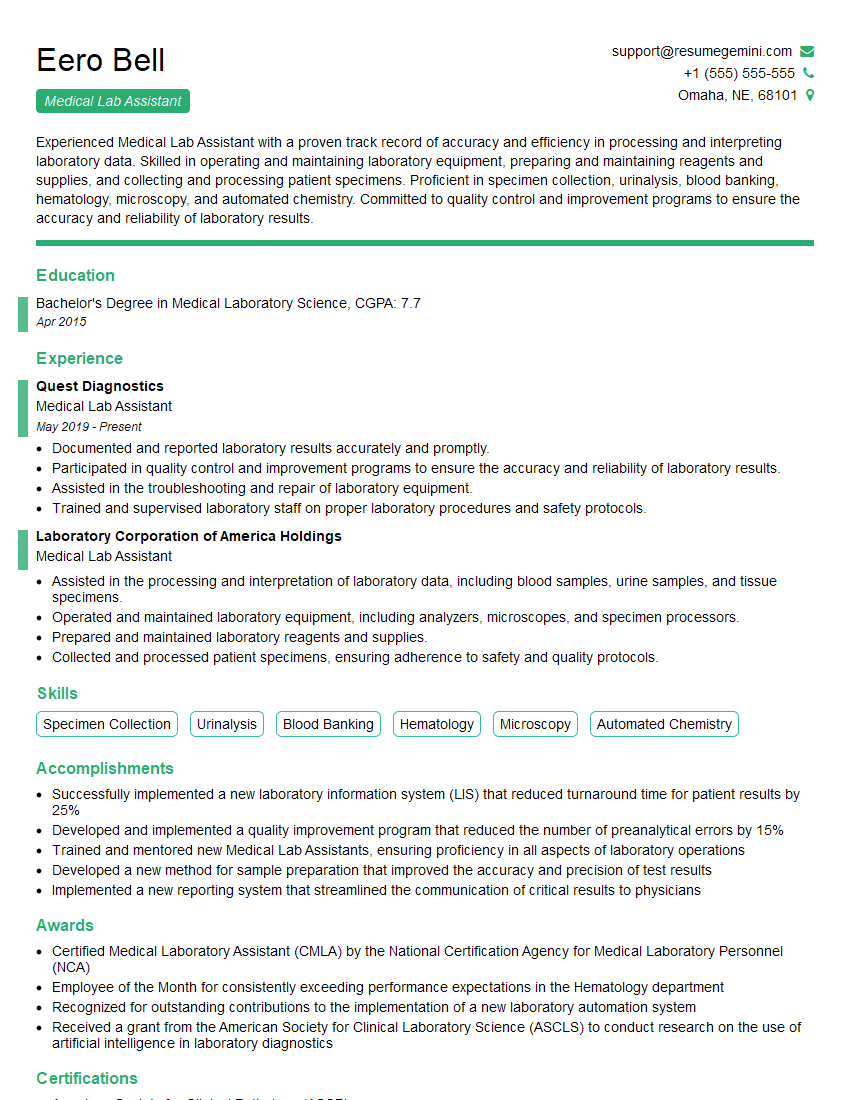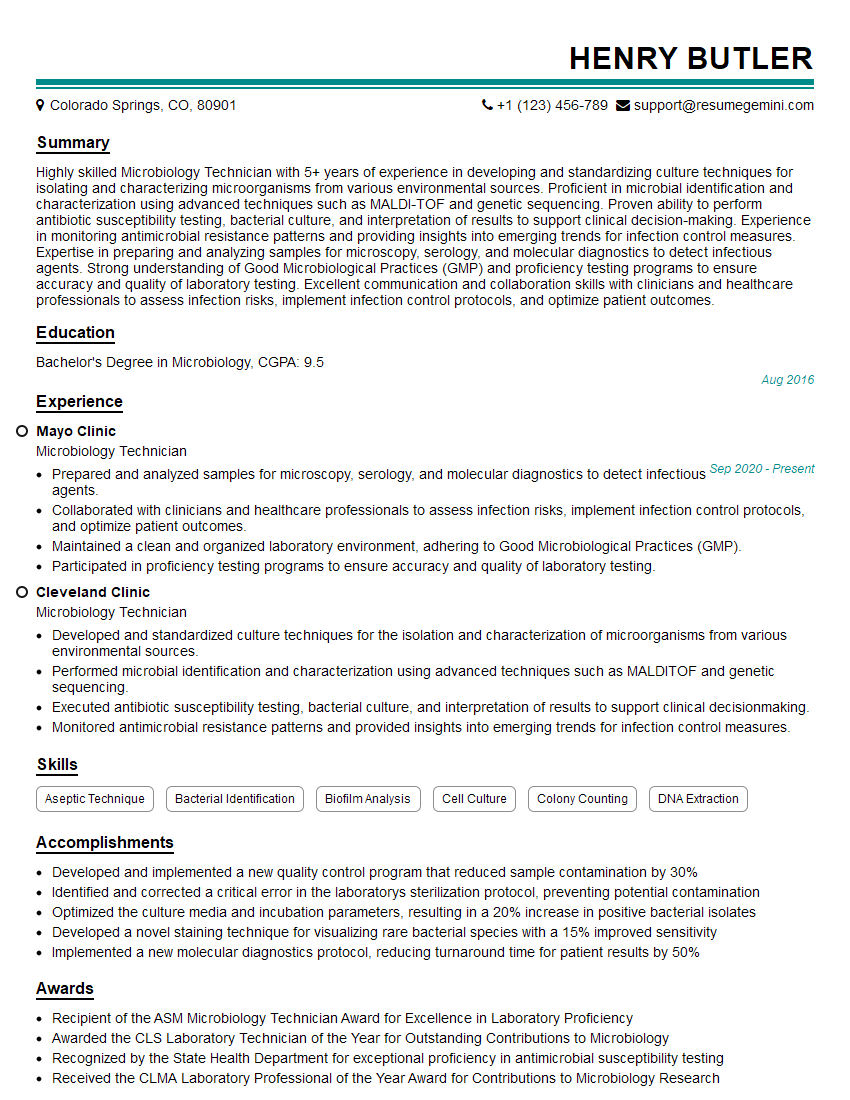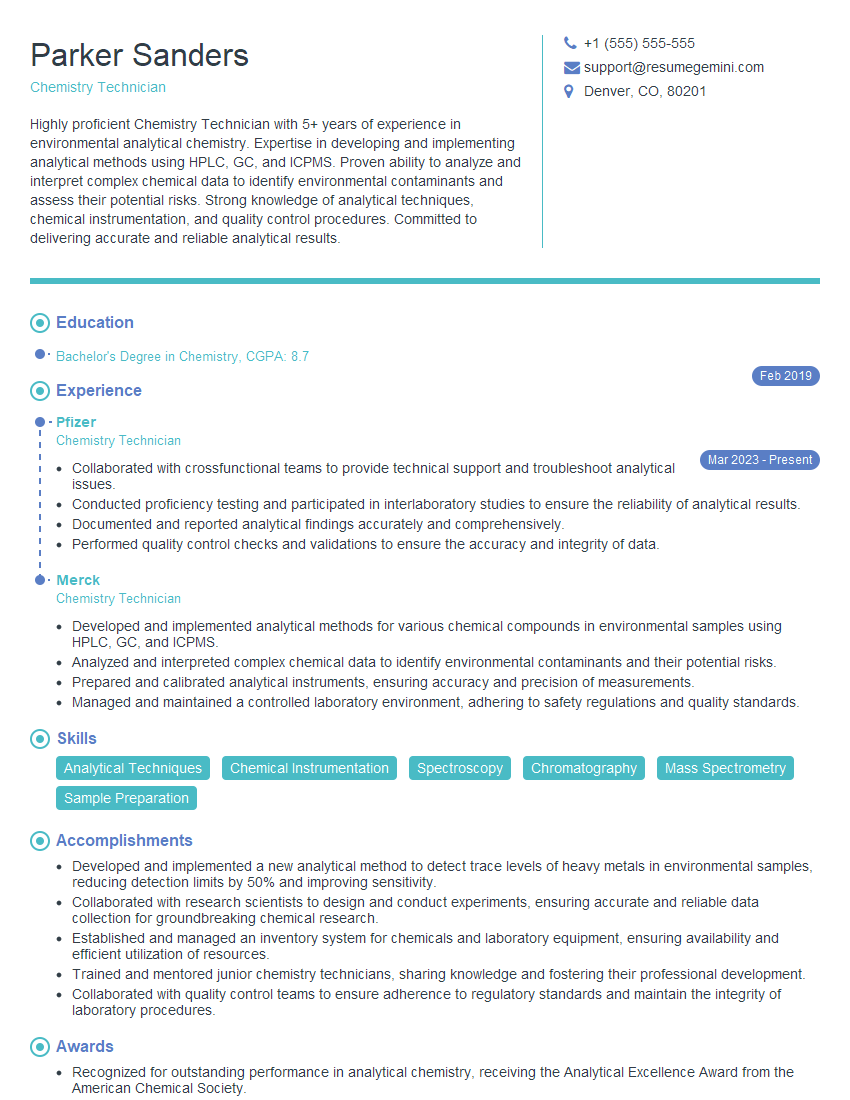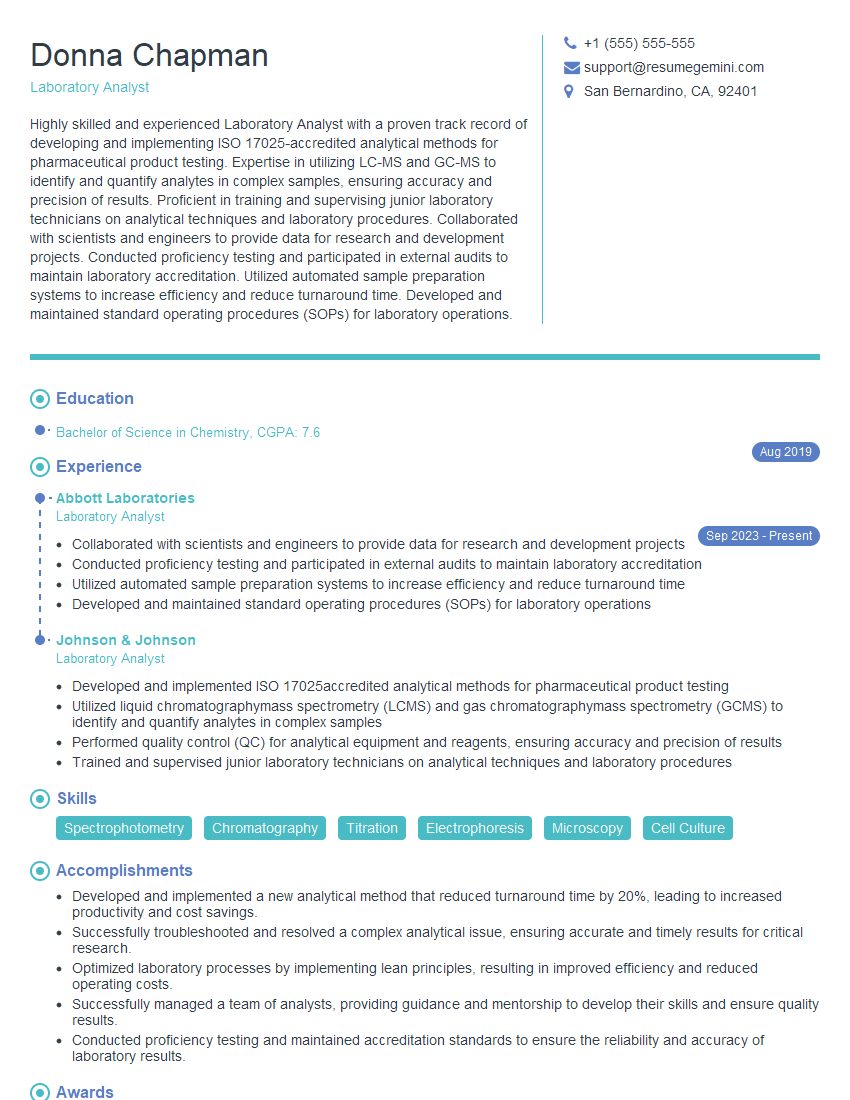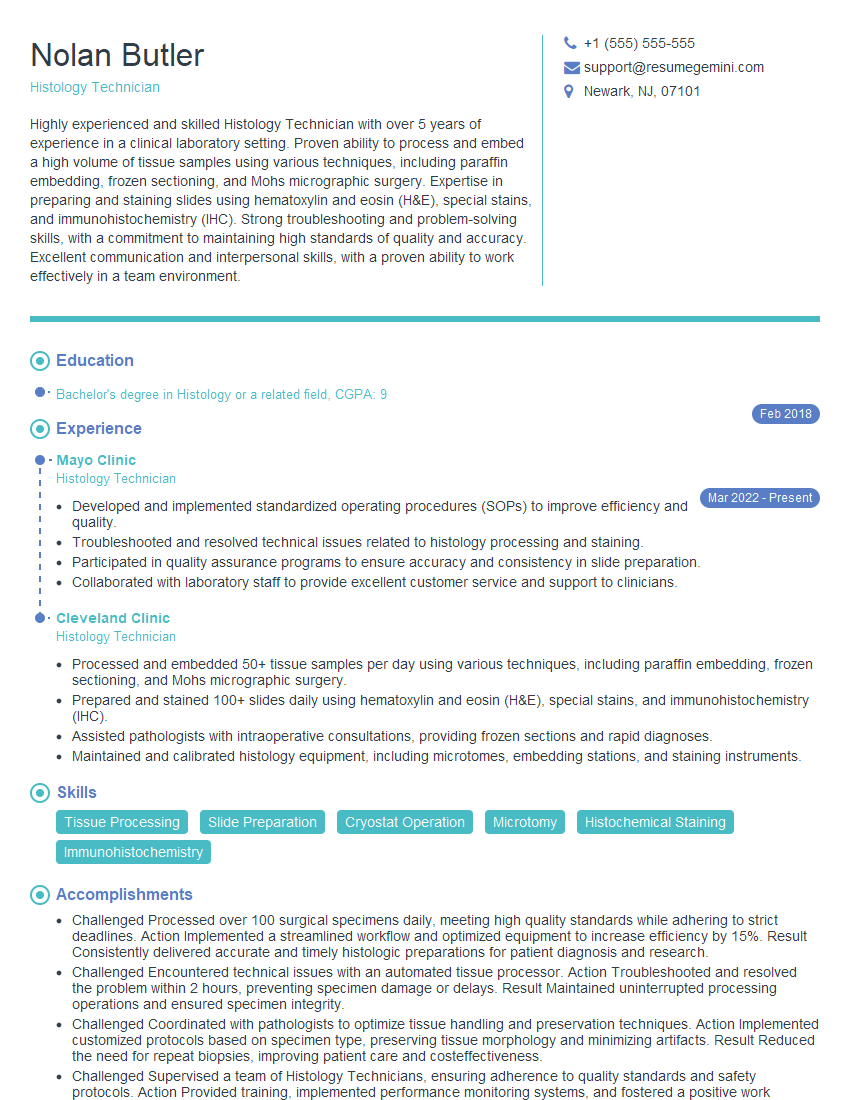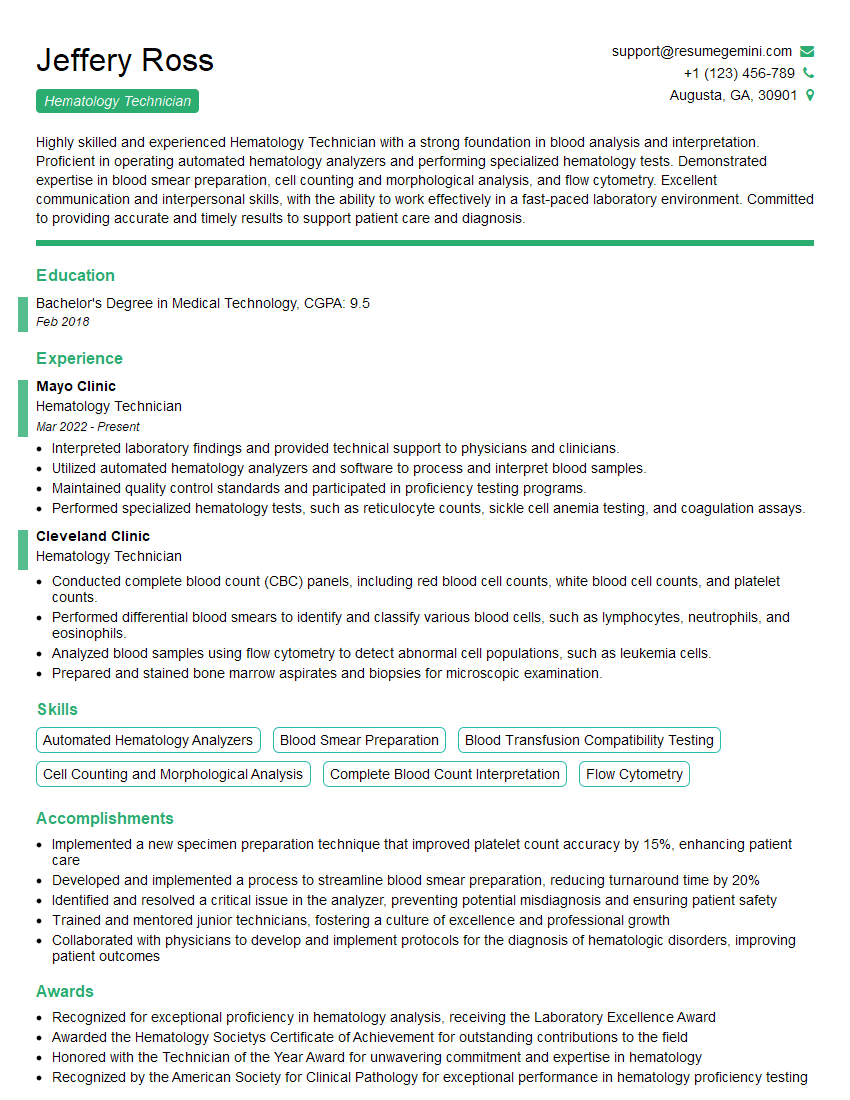Feeling uncertain about what to expect in your upcoming interview? We’ve got you covered! This blog highlights the most important Medical Laboratory Technician interview questions and provides actionable advice to help you stand out as the ideal candidate. Let’s pave the way for your success.
Questions Asked in Medical Laboratory Technician Interview
Q 1. Explain the process of performing a complete blood count (CBC).
Performing a Complete Blood Count (CBC) involves analyzing a blood sample to determine the quantities and characteristics of its cellular components. It’s a fundamental test providing crucial information about a patient’s overall health.
The process typically begins with proper patient identification and sample collection, usually via venipuncture. The collected blood is then mixed with an anticoagulant, such as EDTA (Ethylenediaminetetraacetic acid), to prevent clotting. This sample is then analyzed using automated hematology analyzers. These sophisticated instruments use various techniques, including impedance, laser light scattering, and flow cytometry, to count and differentiate the different blood cells.
Impedance measures changes in electrical resistance as cells pass through a small aperture. Optical techniques (light scattering) utilize lasers to differentiate cells based on size and internal complexity. Flow cytometry analyzes cells individually based on their size, granularity, and fluorescence (after staining with specific dyes).
The analyzer provides a comprehensive report including:
- Red blood cell (RBC) count: The number of red blood cells per microliter of blood.
- Hemoglobin (Hb): The amount of hemoglobin, the oxygen-carrying protein in red blood cells.
- Hematocrit (Hct): The percentage of blood volume occupied by red blood cells.
- Mean corpuscular volume (MCV): The average volume of a single red blood cell.
- Mean corpuscular hemoglobin (MCH): The average amount of hemoglobin per red blood cell.
- Mean corpuscular hemoglobin concentration (MCHC): The average concentration of hemoglobin in a red blood cell.
- Red cell distribution width (RDW): A measure of the variation in the size of red blood cells.
- White blood cell (WBC) count: The total number of white blood cells per microliter of blood, often further broken down into different types (differential).
- Platelet count: The number of platelets per microliter of blood.
Manual microscopic examination of a blood smear may be necessary to confirm automated results or to investigate abnormalities. This involves staining the blood film (e.g., with Wright-Giemsa stain) and visually identifying and counting different types of white blood cells (differential count).
Q 2. Describe the different types of blood cells and their functions.
Blood consists of several types of cells, each with a unique function crucial for maintaining health. Think of it like a well-orchestrated team, each member playing a critical role.
- Red Blood Cells (Erythrocytes): These are the most numerous cells, responsible for carrying oxygen from the lungs to the body’s tissues and returning carbon dioxide to the lungs. Their hemoglobin content is critical for this function. A deficiency in RBCs or hemoglobin (anemia) can lead to fatigue and weakness.
- White Blood Cells (Leukocytes): These cells form the body’s immune defense system. There are various types:
- Neutrophils: The most abundant WBCs, they are crucial in fighting bacterial infections through phagocytosis (engulfing and destroying bacteria).
- Lymphocytes: Involved in specific immune responses, including B cells (producing antibodies) and T cells (directly attacking infected cells).
- Monocytes: Large cells that mature into macrophages, which also engulf and destroy pathogens and cellular debris.
- Eosinophils: Primarily involved in combating parasitic infections and allergic reactions.
- Basophils: Release histamine and other substances involved in inflammatory responses and allergic reactions.
- Platelets (Thrombocytes): These small cell fragments are essential for blood clotting. They adhere to injured blood vessels and aggregate to form a plug, preventing excessive blood loss.
Imbalances in any of these cell types can indicate underlying health problems. For example, a high white blood cell count (leukocytosis) may suggest an infection, while a low platelet count (thrombocytopenia) can increase the risk of bleeding.
Q 3. What are the safety precautions when handling blood samples?
Handling blood samples requires stringent safety precautions to protect both the laboratory personnel and the environment from potential biohazards. The primary focus is on preventing exposure to bloodborne pathogens such as Hepatitis B, Hepatitis C, and HIV.
- Universal Precautions: Treat all blood and body fluids as potentially infectious.
- Personal Protective Equipment (PPE): Always wear gloves, lab coats, and eye protection when handling blood samples. Face shields are recommended for procedures with a high risk of splashes or aerosols.
- Sharps Safety: Use appropriate sharps containers for disposal of needles, lancets, and other sharp objects. Never recap needles.
- Decontamination: Work surfaces should be disinfected with an appropriate disinfectant (e.g., 10% bleach solution) before and after handling specimens. Spills should be cleaned immediately and thoroughly.
- Proper Waste Disposal: All contaminated materials should be disposed of according to established institutional protocols.
- Biohazard Labels: Clearly label all containers containing blood or other potentially infectious materials.
- Engineering Controls: Utilize biological safety cabinets or other safety devices for high-risk procedures.
Strict adherence to these procedures is paramount to minimize the risk of infection and maintain a safe working environment. Regular training and competency assessments are essential to ensure that all personnel understand and follow these protocols. For example, if a needle stick injury occurs, immediate reporting and post-exposure prophylaxis are critical.
Q 4. How do you ensure the accuracy and precision of laboratory results?
Ensuring accuracy and precision in laboratory results is fundamental to providing reliable patient care. It’s a multi-faceted process involving careful attention to every step, from sample collection to result reporting.
- Proper Specimen Collection and Handling: This includes correct patient identification, appropriate anticoagulants, proper labeling, and timely processing to prevent pre-analytical errors.
- Calibration and Maintenance of Instruments: Regular calibration and preventative maintenance of analytical instruments are crucial. This involves using standardized controls and ensuring the instruments are functioning within acceptable parameters. Quality control materials run with patient samples help to monitor this.
- Use of Quality Control Materials: Regularly running quality control (QC) materials alongside patient samples allows for monitoring the accuracy and precision of the tests. This helps detect any systematic errors or drift in the instrument’s performance.
- Proficiency Testing: Participation in external proficiency testing programs provides an independent assessment of the laboratory’s performance compared to other laboratories. This allows identification of areas for improvement.
- Internal Quality Control: Setting up internal quality control procedures helps to maintain standards and ensure consistency. Examples of this are daily or weekly checks of reagents and equipment.
- Documentation and Record Keeping: Meticulous record-keeping of all procedures, results, and quality control data is essential for traceability and troubleshooting.
- Staff Training and Competency: Well-trained and competent personnel are crucial for accurate and reliable results. Continuous professional development is vital to maintain skills and knowledge.
For instance, if QC results fall outside the acceptable range, it necessitates investigation into the cause and corrective actions, which may involve recalibration of the instrument, replacement of reagents, or retraining of personnel. This systematic approach ensures confidence in the results reported.
Q 5. Explain the principles of quality control in a medical laboratory.
Quality control (QC) in a medical laboratory is a systematic process designed to ensure the accuracy, reliability, and timeliness of laboratory testing. It involves a comprehensive set of policies, processes, and procedures that aim to minimize errors and maximize the quality of patient care.
Key aspects of quality control include:
- Pre-analytical Phase: Focuses on proper patient preparation, specimen collection, handling, and transportation. This includes using the correct tubes, avoiding hemolysis (rupture of red blood cells), and ensuring timely processing.
- Analytical Phase: Ensures the accuracy and precision of the analytical methods used. This involves using quality control materials, calibrating instruments, and performing regular maintenance.
- Post-analytical Phase: Focuses on the accurate reporting, interpretation, and storage of results. This includes ensuring accurate transcription, proper communication of results, and secure storage of patient data.
- Internal Quality Control: This involves the use of control materials run alongside patient samples to monitor the performance of the analytical methods. If results fall outside of predetermined acceptable ranges, it indicates a problem that needs to be investigated and corrected.
- External Quality Assessment (EQA): This involves participation in external proficiency testing programs which compare the laboratory’s performance to other laboratories. This helps identify areas for improvement and ensures compliance with standards.
- Documentation and Record Keeping: Meticulous record keeping of all QC procedures, results, and corrective actions is crucial for traceability and continuous improvement.
A robust QC program is essential to minimize errors and ensure that patients receive accurate and reliable laboratory results. The goal is to establish a culture of quality throughout the laboratory, resulting in improved patient outcomes and safety.
Q 6. How do you identify and handle pre-analytical errors in laboratory testing?
Pre-analytical errors are mistakes that occur before the actual laboratory testing process. These errors can significantly affect the accuracy and reliability of results, potentially leading to misdiagnosis and inappropriate treatment. Identifying and handling these errors requires a proactive approach.
Common pre-analytical errors include:
- Incorrect Patient Identification: Using the wrong patient’s sample or labeling the sample incorrectly.
- Improper Specimen Collection: Incorrect collection technique (e.g., hemolyzed blood sample due to forceful aspiration), inadequate volume, or using the wrong type of collection tube.
- Delayed or Improper Specimen Handling: Failure to process the sample within the recommended time frame, inappropriate storage conditions (e.g., improper temperature), or inadequate mixing.
- Patient Non-Compliance: Failure of the patient to follow instructions (e.g., fasting before a glucose test).
- Transcription Errors: Incorrect recording of patient information or test results.
Handling pre-analytical errors involves:
- Prevention: Implementing clear and standardized procedures for specimen collection and handling, providing adequate staff training, and utilizing barcoding or other technologies to reduce manual transcription errors.
- Detection: Regularly auditing laboratory procedures and reviewing patient data to identify patterns of errors. Using quality control metrics can help highlight areas with high error rates.
- Correction: Implementing corrective actions to prevent recurrence, including retraining staff, revising procedures, or purchasing new equipment.
- Documentation: Maintaining meticulous records of all errors, investigations, and corrective actions taken. This aids in continuous improvement and demonstrates compliance with quality standards.
For example, if a pattern of hemolyzed blood samples is observed, it might indicate a need for refresher training on proper venipuncture techniques.
Q 7. Describe your experience with different laboratory instruments and equipment.
Throughout my career, I’ve gained extensive experience with a wide range of laboratory instruments and equipment. This includes automated hematology analyzers (e.g., Sysmex XN series, Coulter LH 750), clinical chemistry analyzers (e.g., Roche Cobas, Siemens Advia), coagulation analyzers (e.g., Siemens STA), and immunoassay analyzers (e.g., Roche Elecsys, Siemens Immulite).
I am proficient in operating and maintaining these instruments, including performing routine quality control checks, troubleshooting malfunctions, and ensuring the accuracy of results. My experience extends to using various laboratory equipment such as:
- Microscopes: For microscopic examination of blood smears, urine sediment, and other specimens.
- Centrifuges: For separating blood components and other specimens.
- Automated pipettes: For precise and accurate sample dispensing.
- Incubators: For maintaining optimal temperature conditions for specific tests.
- Blood gas analyzers: To analyze arterial blood for oxygen, carbon dioxide, and pH levels.
I am also familiar with various laboratory information systems (LIS) for managing patient data, test requests, and reporting results. My ability to adapt to new technologies and my commitment to continuous learning allow me to efficiently utilize a wide array of equipment and software to support optimal laboratory operations.
For example, I once had to troubleshoot a malfunctioning hematology analyzer that was causing inaccurate white blood cell counts. By systematically checking the instrument’s settings, reagents, and performing quality control checks, I was able to identify the problem—a clogged probe—and resolve the issue quickly, ensuring the timely release of accurate patient results.
Q 8. Explain the principles of urinalysis and the significance of different findings.
Urinalysis is a crucial diagnostic tool that involves the physical, chemical, and microscopic examination of urine. It provides valuable insights into the body’s overall health and can detect various diseases.
Physical Examination: This assesses the urine’s color, clarity, and odor. For example, a dark yellow color might suggest dehydration, while cloudy urine could indicate infection.
Chemical Examination: This uses reagent strips to detect various substances, including glucose (indicating diabetes), ketones (suggesting metabolic disorders like diabetic ketoacidosis), protein (potentially kidney damage), bilirubin (liver issues), and blood (possibly urinary tract infection or kidney stones).
Microscopic Examination: A sample of urine is viewed under a microscope to identify cellular components like red blood cells (hematuria, indicating bleeding in the urinary tract), white blood cells (pyuria, suggesting infection), casts (cylindrical structures formed in the kidney tubules and indicative of kidney disease), and crystals (which can point towards various metabolic disorders).
Significance of Findings: Abnormal findings prompt further investigation. For example, the presence of glucose and ketones in a urinalysis, along with other clinical symptoms, would strongly suggest diabetes mellitus. High levels of protein might point toward kidney disease like glomerulonephritis. The identification of bacteria through microscopic examination and culture would confirm a urinary tract infection.
Q 9. How do you perform a Gram stain and interpret the results?
The Gram stain is a differential staining technique used to classify bacteria into two large groups: Gram-positive and Gram-negative. This classification is based on the differences in the structure of their cell walls.
Procedure:
- Prepare a bacterial smear on a clean glass slide and heat-fix it.
- Apply crystal violet (primary stain) for 1 minute, then rinse with water.
- Apply Gram’s iodine (mordant) for 1 minute, then rinse.
- Decolorize with alcohol or acetone for a few seconds, then rinse immediately (this is a crucial step).
- Apply safranin (counterstain) for 1 minute, then rinse.
- Blot dry and observe under a microscope.
Interpretation:
- Gram-positive bacteria retain the crystal violet stain and appear purple. Their thick peptidoglycan layer prevents the decolorizing agent from washing away the primary stain.
- Gram-negative bacteria lose the crystal violet stain during decolorization and take up the safranin counterstain, appearing pink or red. Their thinner peptidoglycan layer and outer membrane allow the decolorizer to remove the crystal violet.
Example: Identifying Staphylococcus aureus (Gram-positive, cocci in clusters) in a wound culture helps guide antibiotic treatment. Conversely, identifying Escherichia coli (Gram-negative, bacilli) in a urine culture confirms a urinary tract infection.
Q 10. Describe the process of blood typing and crossmatching.
Blood typing and crossmatching are essential procedures to ensure blood transfusion safety. Blood typing determines an individual’s ABO and Rh blood groups, while crossmatching tests the compatibility of the donor and recipient blood.
Blood Typing: This involves mixing a drop of the patient’s blood with anti-A, anti-B, and anti-D (Rh factor) antisera. Agglutination (clumping) indicates the presence of the corresponding antigen. For example, agglutination with anti-A and anti-D indicates type A positive blood.
Crossmatching: This is a more comprehensive test involving two stages:
- Major crossmatch: The recipient’s serum is mixed with the donor’s red blood cells. Agglutination indicates incompatibility.
- Minor crossmatch: The recipient’s red blood cells are mixed with the donor’s serum. This is less critical but still important for detecting any unexpected antibodies.
Importance: Incompatible blood transfusions can be life-threatening, causing severe reactions like hemolysis (destruction of red blood cells). Careful blood typing and crossmatching prevent these complications.
Q 11. What are the different types of infectious diseases diagnosed in a medical laboratory?
Medical laboratories diagnose a wide range of infectious diseases using various techniques. Examples include:
- Bacterial infections: Streptococcus (strep throat, pneumonia), Staphylococcus (skin infections, food poisoning), E. coli (urinary tract infections, sepsis), Salmonella (typhoid fever, gastroenteritis), Tuberculosis (TB).
- Viral infections: Influenza, HIV, Hepatitis B and C, Herpes simplex virus, Cytomegalovirus.
- Fungal infections: Candida (candidiasis), Aspergillus (aspergillosis), Cryptococcus (cryptococcosis).
- Parasitic infections: Malaria, Giardiasis, Toxoplasmosis.
Diagnosis often involves microscopic examination, culture techniques, molecular tests (PCR), and serological tests (detecting antibodies).
Q 12. Explain the principles of microbiology testing and identification of pathogens.
Microbiology testing involves the cultivation, identification, and characterization of microorganisms. This plays a vital role in diagnosing infections.
Principles: These methods leverage the unique characteristics of microorganisms, such as their morphology, growth requirements, biochemical reactions, and genetic material.
Identification of Pathogens:
- Culture: Growing microorganisms on different media to observe their colony morphology, growth patterns, and other characteristics.
- Biochemical tests: Determining the metabolic capabilities of microorganisms (e.g., Gram staining, catalase test, oxidase test).
- Molecular tests (PCR): Amplifying specific DNA or RNA sequences to detect and identify microorganisms. This is particularly useful for fastidious organisms which may not grow easily in culture.
- Serological tests: Detecting antibodies against specific pathogens in the patient’s serum, indicating past or current infection.
Example: Isolating Streptococcus pneumoniae from a sputum sample, confirming its identity through Gram stain and biochemical tests, and evaluating its antibiotic susceptibility helps guide treatment for pneumonia.
Q 13. How do you handle and process patient samples to prevent contamination?
Proper handling and processing of patient samples is crucial to prevent contamination and ensure accurate results. Contamination can lead to false positive or negative results, impacting patient care.
Key Practices:
- Use of appropriate personal protective equipment (PPE): Gloves, lab coats, and eye protection are essential to protect lab personnel from potential biohazards.
- Aseptic techniques: Strict adherence to sterile procedures during sample collection, processing, and analysis. This includes working in a laminar flow hood for sensitive tests.
- Proper labeling and identification: Samples must be clearly labeled with patient identifiers to prevent mix-ups. Chain of custody must be maintained.
- Disinfection and sterilization: Work surfaces and equipment should be disinfected regularly. Appropriate sterilization techniques must be used for reusable instruments.
- Disposal of biohazardous waste: Following established guidelines for safe disposal of contaminated materials to prevent environmental contamination and protect healthcare workers.
Example: Failing to properly disinfect a work surface before processing a blood culture may introduce contaminants leading to a false positive result, potentially initiating unnecessary and harmful antibiotic therapy for the patient.
Q 14. Describe your experience with different types of laboratory tests (e.g., ELISA, PCR).
I have extensive experience with a variety of laboratory tests, including ELISA and PCR.
ELISA (Enzyme-Linked Immunosorbent Assay): I have used ELISA for detecting antibodies or antigens in various clinical samples. For example, I’ve performed ELISA tests for infectious disease serology (e.g., HIV, Hepatitis B and C), pregnancy tests, and autoimmune disease markers. ELISA is based on an antigen-antibody reaction, making it a sensitive and specific method.
PCR (Polymerase Chain Reaction): I have experience with real-time PCR for the detection and quantification of nucleic acids (DNA or RNA) of various pathogens, including viruses (e.g., influenza, COVID-19) and bacteria. PCR is an extremely powerful technique with high sensitivity and specificity, ideal for diagnosing infectious diseases even with low levels of the pathogen present. I am proficient in interpreting PCR results and understand the implications of cycle threshold (Ct) values.
Other Tests: My experience also extends to hematology (complete blood counts), coagulation studies, urinalysis, and various other chemistry tests. I am familiar with operating and maintaining various laboratory equipment like automated analyzers, microscopes, and centrifuges.
Q 15. What are the limitations of different laboratory tests?
Every laboratory test, no matter how sophisticated, has limitations. These limitations can stem from several sources, impacting the reliability and interpretability of results.
- Analytical limitations: These are inherent to the test methodology itself. For example, a blood glucose test might have a detection limit – it can’t accurately measure glucose levels below a certain threshold. Another example is the presence of interfering substances in the sample which can falsely elevate or decrease the results, such as bilirubin in certain blood tests.
- Pre-analytical limitations: These relate to factors before the test is even performed. Improper sample collection (e.g., hemolysis – the breakdown of red blood cells – in a blood sample), inadequate patient preparation (e.g., not fasting when required), or delays in processing can significantly alter results. For instance, a delayed blood collection can cause changes in blood cell counts.
- Post-analytical limitations: These occur after the test is completed, including issues with data entry, result reporting, or interpretation. Human error, such as mislabeling a sample or incorrectly entering data into the LIS, can lead to inaccurate results. Inaccurate calibration of the machines is also a major post-analytical limitation.
- Biological Variation: Individuals naturally vary in their blood components. A single result may not be indicative of a problem. This is why we often look at trends over time or compare results against reference intervals (normal ranges) that are specific to the age, gender, and other relevant characteristics of the patient.
Understanding these limitations is crucial for proper interpretation and avoiding misdiagnosis. For instance, a slightly elevated cholesterol level in a single test may not be clinically significant, particularly if lifestyle and other risk factors are considered.
Career Expert Tips:
- Ace those interviews! Prepare effectively by reviewing the Top 50 Most Common Interview Questions on ResumeGemini.
- Navigate your job search with confidence! Explore a wide range of Career Tips on ResumeGemini. Learn about common challenges and recommendations to overcome them.
- Craft the perfect resume! Master the Art of Resume Writing with ResumeGemini’s guide. Showcase your unique qualifications and achievements effectively.
- Don’t miss out on holiday savings! Build your dream resume with ResumeGemini’s ATS optimized templates.
Q 16. How do you interpret and report laboratory results?
Interpreting and reporting lab results is a critical step in patient care. It involves more than just looking at the numbers; it requires a comprehensive understanding of the test, the patient’s clinical picture, and potential interferences.
- Reference Intervals: The first step is to compare the patient’s result to established reference intervals (the normal range). These ranges are population-specific, factoring in age, gender, and other variables. A result outside the reference interval doesn’t automatically indicate a disease; further investigation is often needed.
- Clinical Correlation: The next crucial step is clinical correlation. This means considering the patient’s symptoms, medical history, other lab results, and physical examination findings. An isolated abnormal result might be insignificant in the context of a healthy patient but highly relevant in a patient with a specific illness. For example, a slightly elevated white blood cell count might be normal for a person recovering from an infection, but concerning for someone with no known infection.
- Reporting: Results are communicated using standardized formats, often through a laboratory information system (LIS). The report includes the patient’s identifiers, test names, results, reference intervals, flags for critical values (results indicating immediate medical attention), and any relevant comments or interpretations. Clear, concise, and unambiguous reporting is essential to prevent miscommunication and ensure patient safety.
For example, if a patient’s complete blood count (CBC) shows a significantly low hemoglobin level (anemia), the report would not simply state the hemoglobin value. It would also include flags to denote the low value, and potentially include comments suggesting the need for further evaluation to determine the cause of the anemia.
Q 17. Explain the importance of proper documentation and record-keeping in a medical laboratory.
Proper documentation and record-keeping are paramount in a medical laboratory, forming the backbone of accurate patient care and legal compliance.
- Accuracy and Traceability: Detailed records ensure the traceability of every test performed, from sample collection to result reporting. This is vital for identifying and correcting errors, complying with regulatory requirements, and defending against legal challenges. Each step has to be thoroughly documented, providing a verifiable trail of each testing process.
- Quality Control: Documentation of quality control procedures (e.g., calibration checks, control runs) is essential for demonstrating the accuracy and reliability of test results. This ensures that the testing process is robust and that the results are accurate and reliable.
- Patient Safety: Accurate records minimize the risk of errors. Clear documentation helps prevent misidentification of samples, incorrect interpretation of results, or the administration of inappropriate treatment. This is critical to patient safety, particularly in emergency situations where timely and accurate information is crucial.
- Legal and Regulatory Compliance: Maintaining meticulous records is crucial for meeting regulatory standards (e.g., CLIA, CAP). These regulations mandate specific documentation practices to ensure quality and accuracy. Failure to maintain proper documentation can result in serious penalties.
Imagine a scenario where a patient is wrongly diagnosed due to a mislabeled sample. Thorough documentation would allow an investigation to pinpoint the error, preventing similar incidents in the future. It also protects the laboratory from liability claims.
Q 18. How do you troubleshoot equipment malfunctions in a medical laboratory?
Troubleshooting equipment malfunctions requires a systematic approach. My strategy involves a series of steps, beginning with the most straightforward solutions and progressing to more complex ones.
- Initial Assessment: Start by carefully observing the equipment. What is the specific error message? Are there any unusual sounds or smells? Is there a power issue? Sometimes a simple reboot can resolve the issue. Check all connections and ensure proper power supply.
- Check Manuals and SOPs: Consult the equipment’s operating manual and standard operating procedures (SOPs) for troubleshooting guides. Manufacturers often provide detailed instructions for addressing common problems.
- Basic Checks: Verify that reagents, controls, and calibrators are fresh and correctly prepared. Check for clogs in tubing or other mechanical blockages. Make sure that appropriate maintenance procedures have been recently performed.
- Internal Diagnostics: Many analytical instruments have built-in diagnostic tools. Run these tests to identify the source of the problem. Take note of any error codes, which often correspond to specific issues.
- Seek Assistance: If the problem persists, contact the manufacturer’s technical support or a qualified service engineer. Detailed documentation of the troubleshooting steps is extremely helpful in expediting repair.
For example, if a hematology analyzer displays an error code indicating a clog in the sample probe, I would first visually inspect the probe, then attempt to clear the clog using the manufacturer’s recommended procedures. If the issue remains, I would document my troubleshooting steps and contact technical support.
Q 19. Describe your experience with laboratory information systems (LIS).
I have extensive experience using Laboratory Information Systems (LIS). LIS are crucial for managing all aspects of laboratory operations, from ordering tests to reporting results. My experience encompasses several key functionalities:
- Specimen Tracking: LIS allows me to accurately track specimens from collection to disposal, ensuring samples are properly identified and managed throughout the testing process. Barcoding technology is crucial for this process.
- Test Ordering and Result Reporting: LIS streamlines the process of ordering tests, receiving results, and disseminating them to clinicians. The system helps to automate the process and to ensure results are delivered promptly and efficiently.
- Quality Control Management: LIS facilitates quality control monitoring, recording data and providing alerts if control results are outside of acceptable ranges. This is crucial for ensuring the quality of the testing process and for maintaining accuracy and reliability of the results.
- Data Analysis and Reporting: LIS generates comprehensive reports on laboratory performance, including workload analysis, turnaround times, and error rates. This data supports continuous quality improvement initiatives. I am also familiar with using various data outputs from the LIS for generating custom reports for quality control, audit processes, and trend analysis.
In my previous role, I used the [Name of LIS System, if comfortable sharing; otherwise, omit this section] LIS extensively. I am proficient in using its various modules and functionalities to improve efficiency and accuracy. I’m confident in my ability to navigate and utilize any LIS software efficiently, adapting to different systems quickly.
Q 20. Explain your understanding of laboratory safety regulations and guidelines.
Laboratory safety is paramount. My understanding of safety regulations and guidelines includes adherence to various standards and protocols designed to protect both laboratory personnel and the environment.
- Infection Control: This involves following strict protocols to prevent the spread of infectious agents. This includes proper hand hygiene, use of personal protective equipment (PPE) such as gloves, gowns, and eye protection, and safe disposal of biohazardous waste. Understanding and implementing these infection control measures is fundamental for preventing infections among laboratory personnel and patients.
- Chemical Safety: This involves the safe handling, storage, and disposal of chemicals. Understanding Safety Data Sheets (SDS) for each chemical is crucial. Proper ventilation and the use of fume hoods are essential when working with volatile or hazardous chemicals. Following safe dilution and handling procedures is crucial to protect the technician’s safety and the integrity of the test results.
- Radiation Safety: If the laboratory uses radioactive materials, strict adherence to radiation safety protocols is mandatory. This includes proper shielding, monitoring of radiation levels, and disposal of radioactive waste.
- Biosafety: Following biosafety levels (BSL) and protocols is essential when handling biological samples. This might include the use of biological safety cabinets (BSCs) and other safety precautions designed to contain potentially hazardous biological agents. This is crucial for preventing the spread of infectious diseases within the laboratory.
- Emergency Procedures: Familiarity with emergency procedures, such as fire safety, spill response, and handling of sharps, is critical. Knowing what to do in case of accidents ensures safety for everyone.
Regular safety training and adherence to these guidelines are non-negotiable, forming the basis of a safe and productive work environment.
Q 21. How do you maintain quality control and ensure accuracy in the laboratory?
Maintaining quality control and ensuring accuracy in the laboratory is a continuous process involving several key aspects:
- Calibration and Maintenance: Regularly calibrating and performing preventative maintenance on equipment is crucial to ensure accuracy and precision. Calibration verifies that instruments are providing accurate measurements. Maintenance helps to prevent malfunctions that can compromise the accuracy of test results.
- Quality Control Materials: Using appropriate quality control (QC) materials—controls with known values—in each analytical run is fundamental. Monitoring QC data helps identify systematic errors or problems with the testing process. This ensures that the results produced are within the acceptable range of accuracy.
- Proficiency Testing: Participation in external proficiency testing programs provides an independent assessment of the laboratory’s performance against other labs. This helps to identify areas for improvement and ensure consistent accuracy.
- Internal Audits: Regular internal audits of laboratory procedures, documentation, and equipment help to identify and correct errors, gaps, and deviations from established protocols.
- Standard Operating Procedures (SOPs): Following standardized operating procedures for each test ensures consistency and reproducibility of results. SOPs also provide a detailed guide of testing procedures that can be easily followed by other lab personnel, leading to consistency across the results.
- Personnel Training: Continual education and training for personnel are essential for maintaining a high level of competency and proficiency.
For example, if QC results for a particular test consistently fall outside the acceptable range, it signals a potential problem, prompting an investigation into the cause – perhaps a reagent issue, instrument malfunction, or a procedural error. Addressing these issues promptly ensures accurate and reliable results.
Q 22. Describe a situation where you had to deal with a critical result; how did you handle it?
Handling critical results requires immediate action and precise communication. One instance involved a critically low blood glucose level (hypoglycemia) reported for a patient in the emergency room. Instead of simply reporting the result, I immediately followed our established protocol. This involved:
- Verification: I double-checked the sample identification and the testing procedure to eliminate any possibility of error.
- Immediate Notification: I immediately alerted the attending physician on-call, providing them with the critical result and the patient’s relevant information. This was done verbally, followed by a formal written report.
- Documentation: I meticulously documented every step I took, including the time of notification, the physician’s response, and any corrective actions taken. This is crucial for maintaining a proper audit trail and patient safety.
- Follow-up: I later checked back with the nursing staff to ensure the physician’s orders had been carried out and the patient’s condition was stabilizing. This proactive follow-up is key for a complete picture and ensures patient well-being.
This situation highlighted the importance of precision, rapid response, and clear communication in handling critical results. A delay or miscommunication could have had serious consequences for the patient.
Q 23. How do you manage your time effectively when handling multiple tasks simultaneously?
Efficient time management in a medical laboratory is crucial given the high volume of tests and urgent requests. I employ a few key strategies:
- Prioritization: I use a system to prioritize tasks based on urgency and importance (e.g., STAT orders, routine tests, quality control). This ensures that critical tests are processed immediately.
- Batching: I group similar tests together to streamline the workflow and reduce turnaround times. For example, I might process all the complete blood counts at once.
- Time Blocking: I allocate specific time slots for different tasks to avoid distractions and ensure consistent progress. For example, I might dedicate the first hour of my shift to urgent requests.
- Multitasking Strategically: While I don’t believe in simultaneous multitasking on complex tasks, I utilize downtime effectively. For instance, while waiting for a centrifuge cycle, I can prepare reagents or label samples.
- Effective Organization: Maintaining a clean and organized workspace helps me locate materials quickly, minimizing wasted time. I utilize color-coded systems and efficient storage solutions.
This systematic approach allows me to handle a substantial workload efficiently while maintaining accuracy and upholding high standards of quality in patient care.
Q 24. Describe your experience working as part of a team in a medical laboratory setting.
Teamwork is essential in a medical laboratory. In my previous role, we functioned as a cohesive unit, relying on each other’s strengths and providing mutual support. For example, during a period of high patient volume, we collaboratively adjusted our workload assignments, ensuring that every sample was processed efficiently and accurately. We regularly shared knowledge and training materials, ensuring everyone remained proficient in different laboratory techniques. If one team member encountered a complex case or challenging instrument problem, we engaged in collaborative problem-solving, pooling our experience and skills to find the best solution. We also fostered open communication, reporting any issues or concerns promptly to maintain a smooth workflow and prevent errors. This collaborative environment not only improved overall efficiency but also created a supportive and enjoyable work atmosphere.
Q 25. How do you stay updated with the latest advances in medical laboratory technology?
Keeping abreast of advancements in medical laboratory technology is a continuous process. I actively utilize several methods to stay updated:
- Professional Journals and Publications: I regularly read journals such as Clinical Chemistry and The American Journal of Clinical Pathology to stay informed on the latest research, new technologies, and evolving best practices.
- Continuing Education: I participate in conferences, workshops, and webinars focusing on new laboratory techniques and emerging technologies, such as advances in molecular diagnostics or automation.
- Professional Organizations: Membership in professional organizations like the American Society for Clinical Laboratory Science (ASCLS) provides access to continuing education opportunities, publications, and networking with other professionals in the field.
- Online Resources: Reputable online resources and medical websites provide access to the latest information and guidelines.
- Manufacturer Training: When new equipment is introduced into the laboratory, I actively participate in manufacturer-provided training to master its operation and maintenance.
This multi-pronged approach allows me to continuously enhance my skills and knowledge, ensuring I remain a valuable asset to any laboratory team.
Q 26. What are your strengths and weaknesses as a medical laboratory technician?
My strengths lie in my attention to detail, accuracy, and my ability to work effectively both independently and as part of a team. I am meticulous in my work, ensuring the accuracy of every test result. My ability to remain calm under pressure, especially when handling urgent requests, has proven invaluable in fast-paced laboratory settings. I’m also a quick learner and readily adapt to new technologies and procedures.
A potential area for improvement is my delegation skills. While I’m comfortable working independently, I am working on proactively delegating tasks when appropriate to optimize team efficiency. This is an area I’m actively developing through seeking feedback and taking on leadership opportunities within the lab.
Q 27. Why are you interested in this specific medical laboratory technician position?
I’m highly interested in this position due to [mention specific aspects of the position or the organization that appeal to you]. For example, you could mention the laboratory’s reputation for innovation, its commitment to advanced technologies, or its focus on a particular area of medical testing that aligns with your interests. I am particularly drawn to the opportunity to [mention specific tasks or responsibilities in the job description that excite you] and contribute to a team known for its collaborative approach. This role allows me to utilize my skills in [mention relevant skills] while continually learning and growing in this dynamic field.
Q 28. What are your salary expectations?
My salary expectations are in line with the industry standards for a Medical Laboratory Technician with my experience and qualifications in this geographic area. I am open to discussing a specific range after learning more about the comprehensive compensation package, including benefits.
Key Topics to Learn for Medical Laboratory Technician Interview
- Clinical Chemistry: Understanding analytical techniques (e.g., spectrophotometry, electrophoresis) and their application in diagnosing metabolic disorders. Practical application includes interpreting results and identifying potential errors.
- Hematology: Mastering complete blood count (CBC) analysis, blood smear examination, and coagulation studies. Practical application involves recognizing abnormal cell morphology and correlating findings with patient conditions.
- Immunology & Serology: Knowledge of antibody-antigen reactions and their use in infectious disease diagnosis. Practical application includes performing ELISA or other immunoassays and interpreting results.
- Microbiology: Understanding bacterial identification techniques (e.g., Gram staining, culture methods), fungal and parasitic identification, and antimicrobial susceptibility testing. Practical application involves interpreting culture results and recommending appropriate treatments.
- Urinalysis & Body Fluids: Proficiency in analyzing urine and other body fluids (e.g., cerebrospinal fluid) for various abnormalities. Practical application involves identifying crystals, cells, and other constituents indicative of disease.
- Quality Control & Assurance: Understanding the importance of maintaining quality control in laboratory settings, including proficiency testing and instrument calibration. Practical application includes troubleshooting instrument malfunctions and maintaining accurate records.
- Laboratory Safety & Regulations: Knowledge of safety procedures, infection control, and regulatory compliance (e.g., CLIA). Practical application involves adhering to safety protocols and handling hazardous materials appropriately.
- Data Analysis & Interpretation: Ability to interpret lab results, identify trends, and communicate findings effectively to healthcare professionals. Practical application includes recognizing critical values and communicating them promptly.
- Instrumentation & Maintenance: Familiarity with common laboratory equipment and their operation and maintenance. Practical application includes troubleshooting and performing basic maintenance tasks.
Next Steps
A successful career as a Medical Laboratory Technician offers a fulfilling path with excellent job prospects and opportunities for specialization and advancement. Mastering the essential skills and knowledge discussed above will significantly enhance your interview performance and career trajectory. To increase your chances of landing your dream role, focus on crafting a strong, ATS-friendly resume that highlights your qualifications and experience effectively. ResumeGemini is a trusted resource that can help you build a professional and impactful resume, tailored to the Medical Laboratory Technician field. Examples of resumes specifically designed for this profession are available to guide you through the process.
Explore more articles
Users Rating of Our Blogs
Share Your Experience
We value your feedback! Please rate our content and share your thoughts (optional).
What Readers Say About Our Blog
Hi, I’m Jay, we have a few potential clients that are interested in your services, thought you might be a good fit. I’d love to talk about the details, when do you have time to talk?
Best,
Jay
Founder | CEO
